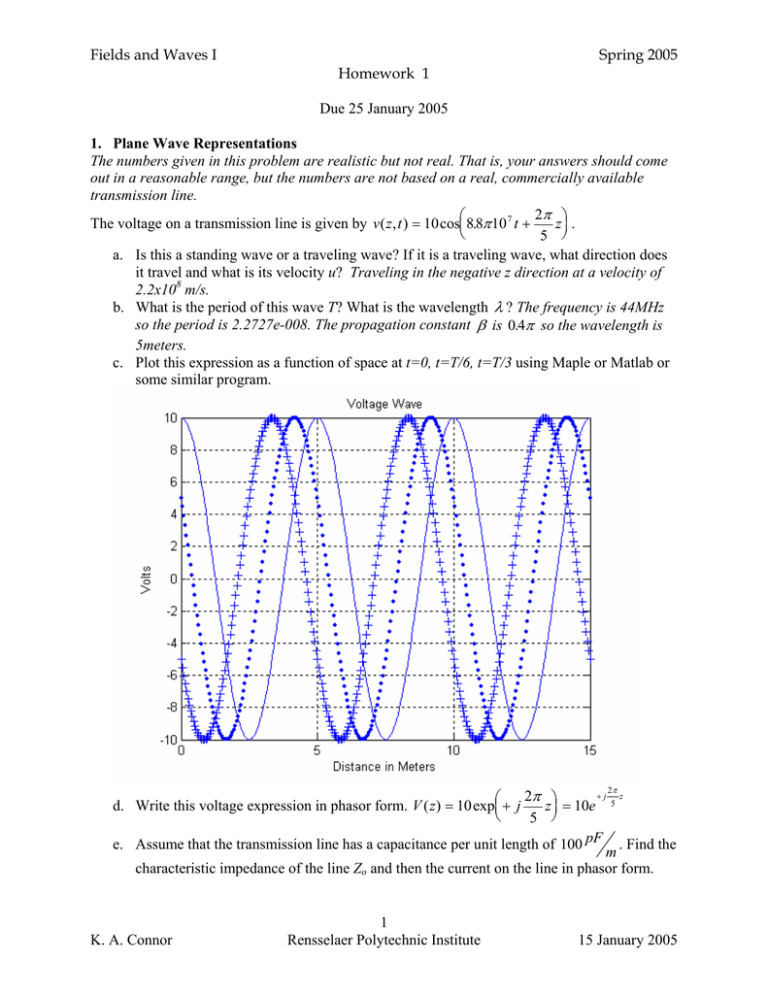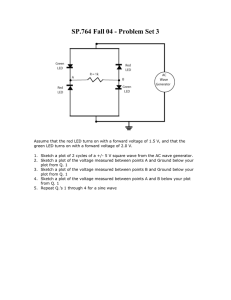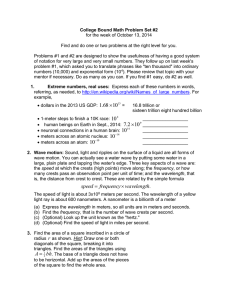Homework 1 Solution - Rensselaer Polytechnic Institute
advertisement

Fields and Waves I
Spring 2005
Homework 1
Due 25 January 2005
1. Plane Wave Representations
The numbers given in this problem are realistic but not real. That is, your answers should come
out in a reasonable range, but the numbers are not based on a real, commercially available
transmission line.
2π ⎞
⎛
The voltage on a transmission line is given by v ( z, t ) = 10 cos⎜ 8.8π 10 7 t +
z⎟ .
⎝
5 ⎠
a. Is this a standing wave or a traveling wave? If it is a traveling wave, what direction does
it travel and what is its velocity u? Traveling in the negative z direction at a velocity of
2.2x108 m/s.
b. What is the period of this wave T? What is the wavelength λ ? The frequency is 44MHz
so the period is 2.2727e-008. The propagation constant β is 0.4π so the wavelength is
5meters.
c. Plot this expression as a function of space at t=0, t=T/6, t=T/3 using Maple or Matlab or
some similar program.
2π
+j
z
2π ⎞
⎛
z⎟ = 10e 5
d. Write this voltage expression in phasor form. V ( z) = 10 exp⎜ + j
⎝
5 ⎠
e. Assume that the transmission line has a capacitance per unit length of 100 pF m . Find the
characteristic impedance of the line Zo and then the current on the line in phasor form.
K. A. Connor
1
Rensselaer Polytechnic Institute
15 January 2005
Fields and Waves I
Spring 2005
Homework 1
The velocity of propagation is related to the inductance and capacitance by u =
one can find the inductance from the capacitance and velocity l =
Now we have enough info to find Z o =
+j
10
I ( z) = −
e
45.4545
sign.
2π
z
5
= −0.22e
+j
2π
z
5
1
so
lc
1
= 2.0661e - 007 .
u2c
l
= 45.4545 . Finally,
c
. Note that the current has to include the minus
2. Reflection of Plane Waves
The waves in the previous problem can exist if the transmission line is properly matched to its
load. That is, the load impedance would have to be equal to Zo. In this problem, we will consider
what happens when there is no load (open circuit).
a. If the load is an open circuit, what is the reflection coefficient at the load Γ L ?
Z − Zo ∞ − Zo
ΓL = L
=
=1
Z L + Zo ∞ + Zo
b. Find the reflected voltage and current waves in phasor form.
2π
2π
2π
2π
−j
−j
z
z
−j
z
Γ L 10 − j 25π z
10 − j 5 z
5
5
VREF ( z) = Γ L 10e
= 10e
and I REF ( z ) =
e
=
e
= 0.22e 5
Zo
45.45
c. Plot the standing wave pattern for both the current and voltage. The simplest way to do
this is to plot the absolute value of the total phasor wave, which Matlab lets us do easily.
For the plots below, the load is located at the right so it is at 15 meters. The dialog used
in Matlab to generate the plots for problems 1 and 2 is found at the end of this solution.
K. A. Connor
2
Rensselaer Polytechnic Institute
15 January 2005
Fields and Waves I
Spring 2005
Homework 1
K. A. Connor
3
Rensselaer Polytechnic Institute
15 January 2005
Fields and Waves I
Spring 2005
Homework 1
1 + ΓL
→∞
1 − ΓL
e. Is the voltage standing wave a maximum, minimum or neither at the load? Is the current
standing wave a maximum, minimum or neither at the load? The voltage is a maximum at
the load while the current is a minimum. This makes physical sense because there cannot
be any current in an open circuit.
f. What is the distance to the closest minimum to the load for both the voltage and current
standing waves? That is, where is the first minimum located that is not at the load? Give
your answer both in meters and in fractions of a wavelength. The first minimum in the
current is 2.5 meters or half a wavelength away. The first minimum in the voltage is 1.25
meters or a quarter of a wavelength away.
d. What is the standing wave ratio in this case? SWR =
3. Lumped Transmission Lines
A transmission line can be replaced by a series of lumped circuit elements, under certain
conditions. In this exercise, you will compare the response of such a lumped model line with the
coil of coax. Obtain a coil of coax, a 50 Ohm terminator and one of the lumped component
transmission lines from a TA.
a. First, we will repeat an experiment from the first studio session at a different frequency. .
Put the 50 Ohm terminator across the output of the coaxial cable and simultaneously
measure input and output signals on the oscilloscope. Set the input voltage at 1VP-P with a
frequency of 2MHz. Measure the time delay between the signals. What else is different
about the input and output voltages? The time delay should be something around 400ns
since the cables are around 80m long and the propagation velocity is about 2x108m/s.
The cable length varies by up to 20m. The output should be a bit smaller than the input.
Add Agilent Intuilink screen capture showing the signals.
b. Replace the coaxial cable with the lumped version and repeat the experiment. The results
will be similar except that usually the attenuation will be a bit smaller. Add Agilent
Intuilink screen capture showing the signals.
c. You should have observed that the lumped line behaves in a qualitatively similar manner
to the spool of coax. Thus, it must represent a similar length of line. We want to
determine the actual length of line. Each L-C combination represents some equivalent
length of line. Since there are 20 such combinations, we only need to figure out what
length each combo represents and multiply it by 20. To understand better how the lumped
circuit is configured, look at the diagram below, done with PSpice. (This diagram has a
load impedance R2 of 93 Ohms, which is not what we are using here.) Note that the
inductance and capacitance for each section is indicated. Given your knowledge of the
actual capacitance and inductance per unit length for the RG58/U coaxial cable, what
length does each section represent? The inductance per unit length is 0.25x10-6. The
inductance of each section is 1x10-6 so each section represents 4 meters of cable. The
same result is obtained from capacitance since the 390pF divided by 100pF per meter is
about 4 meters.
K. A. Connor
4
Rensselaer Polytechnic Institute
15 January 2005
Fields and Waves I
Spring 2005
Homework 1
R1
L1
L2
V1
50
1uH
1uH
C1
390pF
L9
L8
1uH
C9
390pF
390pF
L11
L12
L13
1uH
1uH
C11
L20
1uH
R2
C20
93
390pF
L19
1uH
C19
390pF
390pF
L14
L18
1uH
C18
390pF
1uH
C6
390pF
L15
1uH
C14
390pF
L17
1uH
C17
390pF
390pF
L6
1uH
C13
390pF
C5
390pF
1uH
1uH
C12
390pF
390pF
L7
C7
390pF
1uH
C4
1uH
C8
L5
1uH
C3
390pF
1uH
C10
L4
1uH
C2
L10
0
L3
C15
390pF
390pF
L16
1uH
C16
390pF
Node 15
0
d. Remove the load resistor. Measure the voltage at the 15th node. Adjust the frequency
somewhere between 2MHz and 2.5MHz until the voltage at the 15th node is a minimum. It
should be somewhere around 100mV. Put the terminating resistor back on as a load.
Measure the voltage at each of the nodes for the case where the lumped line is terminated
with 50 Ohms. Remove the resistor and repeat for no load (open circuit). Where are the
minimas and maximas located? (One minimum should be at node 15.) Plot your results
for the measured voltages as a function of distance (using the distance between nodes that
you determined above). Plot your results again but now in terms of wavelength rather
than meters. (You can use the same plot, if you wish, and provide two sets of labels.)
These plots (done with Matlab) are shown on the following pages. Note that the
wavelength plot does not quite come out correctly since the calculated wavelength is
based on the real coaxial cable and the lumped version is only a good approximation.
e. Show that the maximas and minimas are located where they should be in terms of
wavelength. Probably the most dramatic way of doing this is to plot the same function as
in problem 2, the absolute value of the total voltage. We need to change the values of the
wave parameters, which are f=2.4MHz, ω = 2πf = 4.8π 10 6 , u=2x108,
4.8π 10 6
2π
=
= 2.4π 10 − 2 , and λ = 83.3 . The first minimum in the voltage
8
u
83.3
2 x10
should be at a quarter wavelength or 20.8 meters from the load. Our minimum is about 20
meters from the load. The values of the inductors and capacitors are a bit off, so this is
pretty close. The next minimum should be a half wavelength away. According to the plot,
it is about 44 meters away which is just a bit over the half wavelength. Using the values
for the wave parameters and an incident wave amplitude of 1V or 1000mV, the final plot
was obtained. Note that the agreement is remarkably good. The dots are the measured
values and the solid line is for the analytic expression.
β=
ω
K. A. Connor
=
5
Rensselaer Polytechnic Institute
15 January 2005
Fields and Waves I
Spring 2005
Homework 1
Note that the lumped lines work slightly differently if different capacitors are used. Thus, please
note the color of the capacitors on the board you are using. The correct answer to part d will
depend on what capacitors are used on your board.
Measured Data for one of the boxes with orange caps. The frequency for orange is 2.4MHz. The
frequency for blue is 2.25MHz. The one odd box with some red among the blue has a frequency
of 2.67MHz. The data is plotted with Matlab. It can also be plotted with Excel or anything else.
K. A. Connor
6
Rensselaer Polytechnic Institute
15 January 2005
Fields and Waves I
Spring 2005
Homework 1
K. A. Connor
7
Rensselaer Polytechnic Institute
15 January 2005
Fields and Waves I
Spring 2005
Homework 1
Matlab dialog to generate the wave plots for problems 1 and 2:
First I input a velocity and frequency and calculated omega
>> u=2.2e8;f=44e6;w=2*pi*f;
Next I calculated beta
>> B=w/u
B=
1.2566
I am most interested in beta in terms of pi
>> B/pi
ans =
0.4000
Now I add the capacitance per unit length
>> c=100e-12;
Calculate the inductance
>> l=1/((u^2)*c)
l=
2.0661e-007
Calculate the characteristic impedance
>> Z=sqrt(l/c)
Z=
45.4545
Calculating the period
>> T=1/f
T=
2.2727e-008
Calculating the wavelength
>> lam=2*pi/B
K. A. Connor
8
Rensselaer Polytechnic Institute
15 January 2005
Fields and Waves I
Spring 2005
Homework 1
lam =
5
Now to plot the voltage wave, we need a distance array. I have selected the distance to be 3
wavelengths.
>> z=[0:lam/100:3*lam];
First let t=0, then have t=T/6 and t=T/3
Each case is plotted with a different character to show them better.
>> t=0;
>> v=10.*cos(w.*t+B.*z);
>> plot(z,v)
>> hold on; grid;title('Voltage Wave');xlabel('Distance in Meters');ylabel('Volts');
>> t=T/6;
>> v=10.*cos(w.*t+B.*z);
>> plot(z,v,'.')
>> t=T/3;
>> v=10.*cos(w.*t+B.*z);
>> plot(z,v,'+')
Evaluate the amplitude of the current.
>> 10/Z
ans =
0.2200
To plot the standing wave pattern, we first show the total wave in phasor form. Then we plot its
magnitude.
>> Vz=10*exp(j*B.*z)+10*exp(-j.*B.*z);
>> plot(z,abs(Vz));grid;title('Voltage Standing Wave');xlabel('Meters');ylabel('Magnitude of the
Voltage');
Next, we do the same for the current
>> Iz=-2.2*exp(j*B.*z)+2.2*exp(-j.*B.*z);
>> plot(z,abs(Iz));grid;title('Current Standing Wave');xlabel('Meters');ylabel('Magnitude of the
Current');
>>
K. A. Connor
9
Rensselaer Polytechnic Institute
15 January 2005
Fields and Waves I
Spring 2005
Homework 1
Matlab File Used to Plot Measured Results
%Data for standing waves Using the artificial transmission line
%This data was obtained using the lumped component representation of
%an RG58/U cable in JEC 4107.
%K.A. Connor 21 January 2005
%The voltages measured at each of the 21 nodes for no load (open circuit)
v1=[1906 1609 1170 640 250 640 1062 1422 1703 1906 1984 1906 1609 1170 609 109 578
1050 1450 1750 1950];
%The voltages measured at each of the 21 nodes for a matched load (50 Ohms)
v2=[1141 1141 1141 1172 1203 1203 1219 1203 1188 1156 1189 1047 1016 1000 984 984 1000
1000 1000 1016 1031];
%Position on the line
z=[0:4:80];
%Wavelength determined from the velocity on the real RG58/U cable
L=2e8/2.4e6;
%Distance in wavelength (this will not be exactly correct because of small
%variations in the lumped circuit elements
zL=z./L;
plot(z,v1,z,v1,'o',z,v2,z,v2,'+')
grid;title('Voltage Standing Wave');xlabel('Meters');ylabel('mV');figure
plot(zL,v1,zL,v1,'o',zL,v2,zL,v2,'+')
grid;title('Voltage Standing Wave');xlabel('Wavelengths');ylabel('mV');figure
%Use frequency from the experiment and the ideal coaxial cable velocity
f=2.4e6;w=2*pi*f;u=2e8;B=w/u;
%The phasor form of the voltage waves for an open circuit load
Vz=1000*exp(j*B.*(z-80))+1000*exp(-j.*B.*(z-80));
%Plot the calculated voltages (solid line) and measured voltages (red
%circles)
plot(z,abs(Vz),z,v1,'or');grid;title('Voltage Standing Wave');xlabel('Meters');ylabel('Magnitude of
the Voltage in mV');
K. A. Connor
10
Rensselaer Polytechnic Institute
15 January 2005


